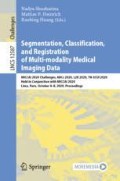Abstract
Careful delineation of normal-tissue organs-at-risk is essential for brain tumor radiotherapy. However, this process is time-consuming and subject to variability. In this work, we propose a multi-modality framework that automatically segments eleven structures. Large structures used for defining the clinical target volume (CTV), such as the cerebellum, are directly segmented from T1-weighted and T2-weighted MR images. Smaller structures used in radiotherapy plan optimization are more difficult to segment, thus, a region of interest is first identified and cropped by a classification model, and then these structures are segmented from the new volume. This bi-directional framework allows for rapid model segmentation and good performance on a standardized challenge dataset when evaluated with volumetric and surface metrics.
Access this chapter
Tax calculation will be finalised at checkout
Purchases are for personal use only
References
Jeanneret-Sozzi, W., et al.: The reasons for discrepancies in target volume delineation: a SASRO study on head-and-neck and prostate cancers. Strahlenther. Onkol. 182(8), 450–457 (2006). https://doi.org/10.1007/s00066-006-1463-6
Brouwer, C.L., et al.: 3D variation in delineation of head and neck organs at risk. Radiat. Oncol. 7, 32 (2012). https://doi.org/10.1186/1748-717X-7-32
González-Villà, S., Oliver, A., Valverde, S., Wang, L., Zwiggelaar, R., Lladó, X.: A review on brain structures segmentation in magnetic resonance imaging (2016). https://doi.org/10.1016/j.artmed.2016.09.001
Cardenas, C.E., Yang, J., Anderson, B.M., Court, L.E., Brock, K.B.: Advances in Auto-Segmentation (2019). https://doi.org/10.1016/j.semradonc.2019.02.001
Ronneberger, O., Fischer, P., Brox, T.: U-Net: convolutional networks for biomedical image segmentation. In: Navab, N., Hornegger, J., Wells, W.M., Frangi, A.F. (eds.) MICCAI 2015. LNCS, vol. 9351, pp. 234–241. Springer, Cham (2015). https://doi.org/10.1007/978-3-319-24574-4_28
De Brébisson, A., Montana, G.: Deep neural networks for anatomical brain segmentation. In: IEEE Computer Society Conference on Computer Vision and Pattern Recognition Workshops, pp. 20–28 (2015). https://doi.org/10.1109/CVPRW.2015.7301312.
McClure, P., et al.: Knowing What You Know in Brain Segmentation Using Bayesian Deep Neural Networks (2019). https://doi.org/10.3389/fninf.2019.00067. https://www.frontiersin.org/articles/10.3389/fninf.2019.00067/full
Shusharina, N., Bortfeld, T., Cardenas, C.E.: MICCAI 2020 ABCs Challenge. https://abcs.mgh.harvard.edu/index.php.
Oktay, O., et al.: Attention U-Net: Learning where to look for the pancreas. arXiv. (2018)
Milletari, F., Navab, N., Ahmadi, S.A.: V-Net: Fully convolutional neural networks for volumetric medical image segmentation. In: Proceedings - 2016 4th International Conference on 3D Vision, 3DV 2016, pp. 565–571 (2016). https://doi.org/10.1109/3DV.2016.79
Kingma, D.P., Ba, J.: Adam: A Method for Stochastic Optimization (2014)
Szegedy, C., Ioffe, S., Vanhoucke, V., Alemi, A.A.: Inception-v4, inception-ResNet and the impact of residual connections on learning. In: 31st AAAI Conference on Artificial Intelligence, AAAI 2017, pp.. 4278–4284 (2017)
Nikolov, S., et al.: Deep learning to achieve clinically applicable segmentation of head and neck anatomy for radiotherapy. arXiv (2018)
Moeskops, P., et al.: Evaluation of a deep learning approach for the segmentation of brain tissues and white matter hyperintensities of presumed vascular origin in MRI. NeuroImage Clin. 17, 251–262 (2018). https://doi.org/10.1016/j.nicl.2017.10.007
Luna, M., Park, S.H.: 3D Patchwise U-Net with transition layers for MR brain segmentation. In: Crimi, A., Bakas, S., Kuijf, H., Keyvan, F., Reyes, M., van Walsum, T. (eds.) BrainLes 2018. LNCS, vol. 11383, pp. 394–403. Springer, Cham (2019). https://doi.org/10.1007/978-3-030-11723-8_40
Wang, Y., Zhao, L., Wang, M., Song, Z.: Organ at risk segmentation in head and neck CT images using a two-stage segmentation framework based on 3D U-net. IEEE Access. 7, 144591–144602 (2019). https://doi.org/10.1109/ACCESS.2019.2944958
Rhee, D.J., et al.: Automatic detection of contouring errors using convolutional neural networks. Med. Phys. 46, 5086–5097 (2019). https://doi.org/10.1002/mp.13814
Court, L.E., et al.: Radiation planning assistant - a streamlined, fully automated radiotherapy treatment planning system. J. Vis. Exp. 2018, e57411 (2018). https://doi.org/10.3791/57411
Acknowledgements
The authors acknowledge the support of the High Performance Computing facility at the University of Texas MD Anderson Cancer Center and the Texas Advanced Computing Center (TACC) at The University of Texas at Austin for providing computational resources that have contributed to the research results reported in this paper.
Author information
Authors and Affiliations
Corresponding author
Editor information
Editors and Affiliations
Rights and permissions
Copyright information
© 2021 Springer Nature Switzerland AG
About this paper
Cite this paper
Gay, S.S. et al. (2021). A Bi-directional, Multi-modality Framework for Segmentation of Brain Structures. In: Shusharina, N., Heinrich, M.P., Huang, R. (eds) Segmentation, Classification, and Registration of Multi-modality Medical Imaging Data. MICCAI 2020. Lecture Notes in Computer Science(), vol 12587. Springer, Cham. https://doi.org/10.1007/978-3-030-71827-5_6
Download citation
DOI: https://doi.org/10.1007/978-3-030-71827-5_6
Published:
Publisher Name: Springer, Cham
Print ISBN: 978-3-030-71826-8
Online ISBN: 978-3-030-71827-5
eBook Packages: Computer ScienceComputer Science (R0)

